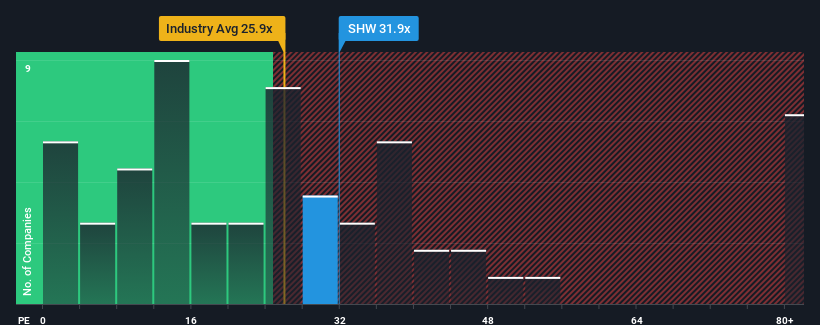- United States
- /
- Chemicals
- /
- NYSE:SHW
The Sherwin-Williams Company's (NYSE:SHW) Price Is Out Of Tune With Earnings

When close to half the companies in the United States have price-to-earnings ratios (or "P/E's") below 17x, you may consider The Sherwin-Williams Company (NYSE:SHW) as a stock to avoid entirely with its 31.9x P/E ratio. Although, it's not wise to just take the P/E at face value as there may be an explanation why it's so lofty.
Sherwin-Williams certainly has been doing a good job lately as its earnings growth has been positive while most other companies have been seeing their earnings go backwards. It seems that many are expecting the company to continue defying the broader market adversity, which has increased investors’ willingness to pay up for the stock. If not, then existing shareholders might be a little nervous about the viability of the share price.
See our latest analysis for Sherwin-Williams

Does Growth Match The High P/E?
The only time you'd be truly comfortable seeing a P/E as steep as Sherwin-Williams' is when the company's growth is on track to outshine the market decidedly.
If we review the last year of earnings growth, the company posted a terrific increase of 15%. EPS has also lifted 21% in aggregate from three years ago, mostly thanks to the last 12 months of growth. So we can start by confirming that the company has actually done a good job of growing earnings over that time.
Shifting to the future, estimates from the analysts covering the company suggest earnings should grow by 8.9% per year over the next three years. Meanwhile, the rest of the market is forecast to expand by 9.9% per annum, which is not materially different.
In light of this, it's curious that Sherwin-Williams' P/E sits above the majority of other companies. Apparently many investors in the company are more bullish than analysts indicate and aren't willing to let go of their stock right now. Although, additional gains will be difficult to achieve as this level of earnings growth is likely to weigh down the share price eventually.
The Key Takeaway
Using the price-to-earnings ratio alone to determine if you should sell your stock isn't sensible, however it can be a practical guide to the company's future prospects.
Our examination of Sherwin-Williams' analyst forecasts revealed that its market-matching earnings outlook isn't impacting its high P/E as much as we would have predicted. Right now we are uncomfortable with the relatively high share price as the predicted future earnings aren't likely to support such positive sentiment for long. Unless these conditions improve, it's challenging to accept these prices as being reasonable.
We don't want to rain on the parade too much, but we did also find 1 warning sign for Sherwin-Williams that you need to be mindful of.
If you're unsure about the strength of Sherwin-Williams' business, why not explore our interactive list of stocks with solid business fundamentals for some other companies you may have missed.
New: Manage All Your Stock Portfolios in One Place
We've created the ultimate portfolio companion for stock investors, and it's free.
• Connect an unlimited number of Portfolios and see your total in one currency
• Be alerted to new Warning Signs or Risks via email or mobile
• Track the Fair Value of your stocks
Have feedback on this article? Concerned about the content? Get in touch with us directly. Alternatively, email editorial-team (at) simplywallst.com.
This article by Simply Wall St is general in nature. We provide commentary based on historical data and analyst forecasts only using an unbiased methodology and our articles are not intended to be financial advice. It does not constitute a recommendation to buy or sell any stock, and does not take account of your objectives, or your financial situation. We aim to bring you long-term focused analysis driven by fundamental data. Note that our analysis may not factor in the latest price-sensitive company announcements or qualitative material. Simply Wall St has no position in any stocks mentioned.
About NYSE:SHW
Sherwin-Williams
Engages in the development, manufacture, distribution, and sale of paint, coatings, and related products to professional, industrial, commercial and retail customers.
Solid track record average dividend payer.
Similar Companies
Market Insights
Community Narratives



